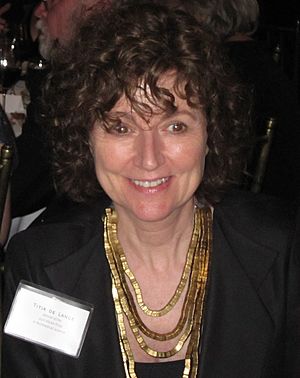Titia de Lange facts for kids
Quick facts for kids
Titia de Lange
|
|
|---|---|

Titia de Lange at the Vilcek Prize Ceremony in 2011
|
|
| Born |
Titia de lange
November 11, 1955 |
| Nationality | Dutch |
| Alma mater | University of Amsterdam (Ph.D) |
| Known for |
|
| Awards |
|
| Scientific career | |
| Fields | Molecular Biology, Cell Biology, and Genetics |
| Institutions | |
| Doctoral advisor | Piet Borst |
Titia de Lange (born November 11, 1955) is a Dutch scientist famous for her work on genetics and cell biology. She is a professor at Rockefeller University and leads a lab that studies parts of our DNA called telomeres.
De Lange made important discoveries about how our cells protect their DNA. Her research helps us understand aging and how cancer develops. For her amazing work, she won the Breakthrough Prize in Life Sciences in 2013, which came with a $3 million prize.
Contents
Early Life and Education
Titia de Lange was born in Rotterdam, Netherlands. After high school, she wanted to study chemistry. However, she noticed very few women in that field at the time. So, she decided to study biology and biochemistry instead.
She attended the University of Amsterdam, where she earned her master's degree in 1981 and her Ph.D. in 1985. For her Ph.D., she worked at the Netherlands Cancer Institute. In 1985, she moved to the United States for more research at the University of California, San Francisco. Since 1990, she has worked at Rockefeller University in New York City, where she runs her own laboratory.
Unlocking the Secrets of Telomeres
De Lange's research focuses on telomeres. Telomeres are special caps at the ends of our chromosomes. You can think of them like the plastic tips on shoelaces that stop the laces from fraying. In the same way, telomeres protect our chromosomes from getting damaged.
Our chromosomes hold all our genetic information, like a set of instruction manuals for our body. Every time a cell divides, these instructions need to be copied.
Why are Telomeres Important?
During her research, de Lange made a key discovery. She found that telomeres get a little shorter each time a cell divides. This is a natural part of aging.
She also noticed that in many cancer cells, the telomeres were much shorter than normal. This finding was a big step in connecting telomeres to both aging and cancer. Without proper telomeres, the ends of chromosomes can become "sticky" and fuse together, causing major problems for the cell.
The Discovery of Shelterin
De Lange wanted to know exactly how telomeres protect our DNA. Her lab worked to find the proteins that attach to telomeres. In 1995, her team identified an important protein called TRF1. They later found another one called TRF2, which stops chromosome ends from sticking together.
One of her biggest discoveries was realizing that six of these proteins work together as a team. In 2005, she named this protein group shelterin, because it "shelters" or protects the chromosome ends.
The shelterin complex forms a shield around the telomere. This shield hides the end of the chromosome from the cell's own repair systems. Normally, these systems would see a DNA end as a break that needs to be fixed. Shelterin tells the cell, "Don't worry, this end is supposed to be here!"
This research has been very important. It has helped scientists all over the world better understand how our cells work and what goes wrong in diseases like cancer.
Awards and Recognition
Titia de Lange has received many awards for her groundbreaking research. Some of her most important honors include:
- The Paul Marks Prize for Cancer Research in 2001
- The Heineken Prize for Biochemistry and Biophysics in 2012
- The Breakthrough Prize in Life Sciences in 2013
- The Canada Gairdner International Award in 2014
- The Rosenstiel Award in 2017
She is also a member of several respected science organizations, including the U.S. National Academy of Sciences and the Royal Netherlands Academy of Arts and Sciences. In 2022, she was elected a Foreign Member of the Royal Society in the United Kingdom.

